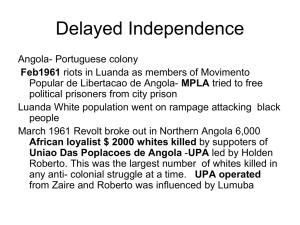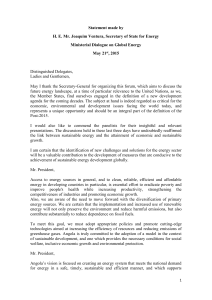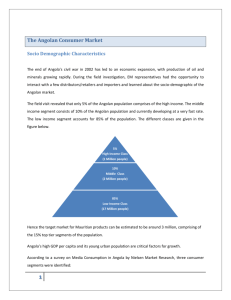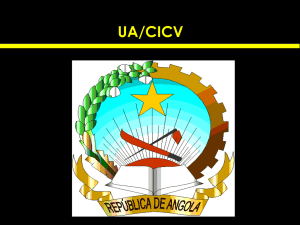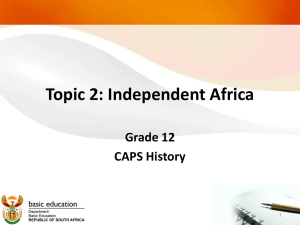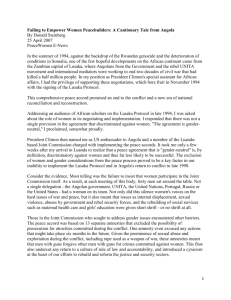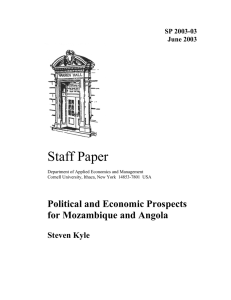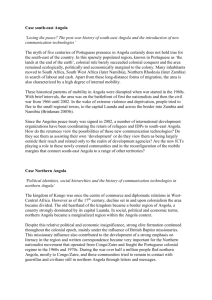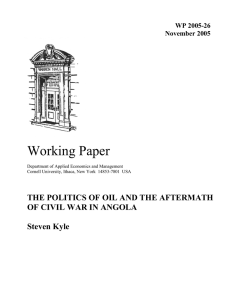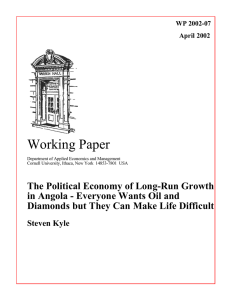Working Paper Oil and Politics in Angola Steven Kyle
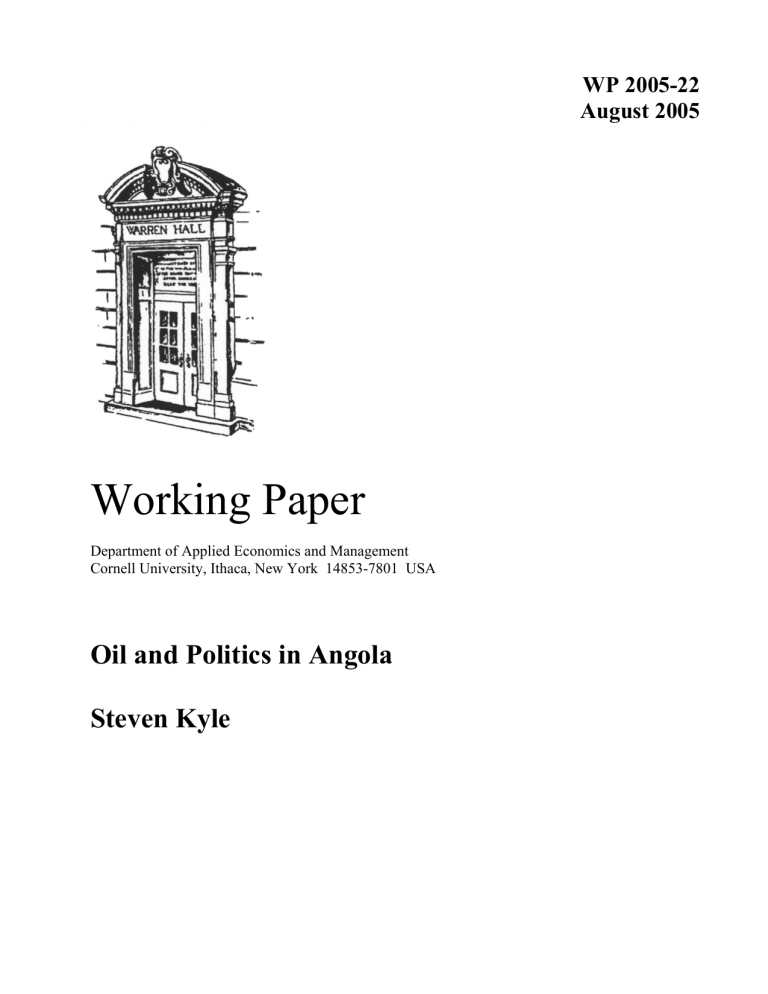
Working Paper
Department of Applied Economics and Management
Cornell University, Ithaca, New York 14853-7801 USA
Oil and Politics in Angola
Steven Kyle
WP 2005-22
August 2005
Abstract
Oil and Politics in Angola
Steven Kyle
This paper discusses some of the links between Angola’s oil wealth and its domestic and international political situation. These include direct effects such as the role of mineral revenue in prolonging and intensifying the recently ended civil war, and the ability of the government to use oil revenue to both buy off and to suppress dissent internally. Also important are indirect effects which are felt primarily through the sectoral and regional results of extreme real exchange rate appreciation caused by large inflows of mineral revenue.
2
Oil and Politics in Angola
Steven Kyle
Cornell University
August 2005
I. Introduction
It is tempting to view Angolan politics solely through the lens of its status as the second largest oil exporter in Sub Saharan Africa. Certainly the immense flows of revenue have had a major impact on both the decades long civil war and the politics of the period since its end but it is also the case that Angola has long standing political divides which predated the discovery of oil and which will remain after it is gone. These divisions result from the regional, social and economic structure of the country and their origins can be traced back to the earliest days of Portuguese occupation. The oil riches, large though they are, have lasted for a quarter century and can be expected to last no longer than another quarter century. This means that an Angolan born today will spend the most productive years of his or her life in a country which is a former oil exporter but which has clearly seen the peak of its mineral revenue come and go.
Nevertheless, oil (and diamonds to some extent) are obviously a major factor at the present time and make the question of the relationship between mineral income and politics an import one. This brief paper will first touch upon the size of the revenue stream compared to the Angolan economy; second some reflections on the role of oil revenue in the internal conflicts in the country, followed by a discussion of the direct and indirect effects of oil revenue on internal politics and foreign policy. A final section looks at these issues in a long run context, discussing the links between oil induced distortions and pre-existing socio-economic structures.
How Much Oil?
Angola produced somewhere in the vicinity of 1 million bbd in 2004 mainly from its enclave province of Cabinda and from offshore wells. This figure is set to increase sharply in 2005 and thereafter as new production comes on line. It is anticipated that exports will reach approximately 2 million bbd within the next two to three years and will peak sometime in the half decade after 2010. Revenue projections are of course subject to the fluctuations of international prices which have currently risen well above $60/bbl.
(See Figure 1).
This puts Angola in second place among African oil producers (See Figure 2) making it one of the two major exporters together with Nigeria. Angola currently accounts for about 5% of US imports (See Figure 3) though this is a largely irrelevant
* Presented to the National Intelligence Council August 30, 2005
3
fact given the globalized nature of the world oil market.
† As oil production increases in
the coming years the already extreme nature of Angola’s oil dependence (See Figure 4) will increase, making it one of the most oil-dependent countries in the world, rivaling even some countries in the Persian Gulf. (See Table 1)
Angolan offshore oil has proven to contain much larger amounts than had been originally anticipated. Indeed, in the most productive areas new wells are proving out as commercially viable at rates as high as 80%, a figure reminiscent of those enjoyed in such places as Saudi Arabia. However, in spite of this, current estimates of production do indicate a peak in the next decade with a gradual decline thereafter.
II. Mineral Income, Internal Conflict and Politics
There can be little doubt that the length and ferocity of Angola’s civil war owed much to its oil and diamond income. Where other African countries engaged in civil conflict had little in the way of income to maintain a sustained struggle or to purchase equipment for armed forces, Angola’s two sides each had significant income, the government from oil and UNITA from diamonds. This money not only delayed the resolution of the conflict but also contributed to the extreme levels of destruction found through much of the Angolan interior.
Some authors have even documented direct links between military offensives and
receipts of large payments for oil rights.
‡ It is obvious even now that oil revenues are
directly related to government initiatives, with little effort made to cultivate alternative sources of income. One major consequence of this is the extreme centralization of political authority. This is something that flows naturally from the colonial heritage of
Angola but is clearly reinforced by the centralized nature of oil income. Indeed, even the government’s “decentralization initiative” does devolve budgetary authority to lower levels. The central government will retain control of the purse strings even if nominal political authority is delegated to provincial or lower levels.
Government use of oil revenue to prosecute its war aims has clear analogues in peacetime. Oil revenues will continue to be used to pursue the aims of the government and to suppress dissent and/or buy off opposition. In this the Angolan political system is no different from any other in that a politician’s first priority is to ensure continuity in power. This is achieved most obviously by suppressing opposition and rewarding constituents. Suppression of opposition is (and was through the war years) clearly related to a well equipped army which was victorious in its war against UNITA and also useful
† It is worth noting that there are two possible caveats to this statement: First, to the extent that Angola engages in oil backed borrowing, then production is not in fact merely an addition to global supplies; it is already owned by the creditor. Second, in the event that there are future oil market disruptions resulting in
‡ political or administrative allocation of oil, the current market driven system could be superseded.
See, e.g. J. Frynas and G. Wood, “Oil & War in Angola” Review of African Political Economy - Vol. 28
No. 90 Dec. 2001
4
in maintaining internal control. Angola is notable in that there has been no real involvement of the military in politics and no questioning of civilian control.
The most direct example of rewarding constituents is subsidies on oil products.
These have been heavily subsidized in the past though recent price increases have reduced the subsidy element (only to see it increased again as oil prices go up). It is important to note that this is a relatively “easy” subsidy for the government in that it does not involve out-of-pocket expenditures: oil products are provided at a fraction of the world price but still at a price that covers production costs.
In the run-up to national elections it is to be expected that the government will do what it can to influence opinions by engaging in high visibility projects to benefit voters.
It is to be hoped that such expenditures do not endanger the hard won stability of prices that has been achieved. However, the elections in themselves will likely give rise to the general question of where all the oil revenue has gone. The stock answer to date has been that oil receipts have all been used to prosecute the war, but the end of hostilities almost three years ago led to the expectation of some “peace dividend” as these flows were redirected toward civilian ends. The obvious question is “where has the money gone?”.
A. Where Has the Money Gone? (And Other Election Related Issues)
The first answer is obviously corruption. While there may be a fuzzy line between legitimate public works expenditures and pork barrel projects to benefit constituents, it is clear that in the Angolan case billions of dollars have simply disappeared over the past several years. Various authors and organizations have publicized this fact and it is one the Angolan leadership feels rather uncomfortable about, though there is no chance of any money being recovered.
A second answer, and one potentially as large as the first in dollar terms is the massive expenditures on stabilizing the Kwanza that have been made since the middle of
2003. In a nutshell, rather than controlling fiscal deficits, which have been the root cause of Angola’s inflationary tendencies, the government has instead chosen to use foreign exchange earnings to purchase excess Kwanzas emitted by the government in support of its expenditures. These purchases of Kwanzas have reached levels in the vicinity of $250 million per month or between $2 and $3 billion per year. These amounts are staggering compared to the size of the economy, and represent a huge diversion of foreign exchange.
While successful in achieving the goal of lower inflation, this policy has not only been extremely expensive but has also resulted in a marked appreciation of the real exchange rate, something with important political ramifications of its own. (See section on “Dutch
Disease” below)
Both this question and the desire to see a change are likely to contribute to a reduced MPLA majority in the national elections now scheduled for 2006 (originally
2004, later delayed to 2005 before being moved to 2006). While most observers assume that the MPLA will emerge victorious, due not only to their control of the government
5
apparatus and wealth but also to the disarray of opposition parties, a reduced majority will lead to a much more contentious situation in the National Assembly than at the present time.
The MPLA knows that there is a need for turnover among parliamentarians, most of whom have been in place for more than a decade. Though there is no expectation that the ruling inner leadership of the MPLA will lose power, there is likely to be a substantial shakeup of the lower end of the MPLA list. It is also important to remember that even in the event of a reduced majority, the MPLA will retain power by virtue of its possession of the Presidency given that Angola’s political system is set up to give the President very strong powers.
It is clear that the MPLA desires the elections to be seen as free and fair. While it is hard for many to imagine that the party would allow itself to be voted out of power, it is also clear that there is not likely to be any need to “fix” the election to make this outcome happen. Perhaps the biggest problem is to convince the population that elections are important and that they should participate. Past history has demonstrated that elections are a dangerous time in Angolan politics and there are many who fear turmoil given the results of the last election that was held.
B. Angola and the IMF & World Bank
Angolan relations with the international financial institutions have been somewhat rocky over the years, with the recurrent bouts of hyperinflation and control preventing any lasting accord with the IMF. Indeed, even achieving a successful Article IV consultation (requiring collection of basic economic statistics in a consistent manner) with the IMF has been extremely difficult until this year given the abysmal state of statistics over most of the past 20 years. Relations with the World Bank have not been much better given the Bank’s reluctance to do much more than emergency/humanitarian assistance projects in the absence of an agreed framework with the IMF. The role of oil money in this history has been important – the Angolan leadership, unlike most other countries at a similar level of development, has its own source of foreign exchange. This means that the need for the foreign exchange that the IMF and World Bank can bring is far less pressing than in other countries, therefore rendering the leverage that these institutions can exert far less effective.
However, there has been real progress on this front over the past two years as the government has made a concerted effort to do what is necessary to gain acceptance of their policies by the IMF, thus opening the door for improved relations (and development projects) from the World Bank and other major donors. Not only has the country now successfully completed an Article IV consultation with the fund, but it has stabilized its exchange rate, unified the parallel and official markets for foreign exchange, and brought inflation down to single digit levels. Perhaps more important, it has taken much-needed steps toward real transparency in government and oil company accounts.
6
Nevertheless, it is still unlikely that a true Staff Monitored Program (SMP) will be agreed on any time in the near future. Indeed, as the government’s policies have had the desired effects it has seemed that there has been less and less pressure on the leadership to finalize a formal agreement. At the present time the IMF is positive on the Angolan government’s recent performance in terms of economic management and is aware of (and tolerant of) the likelihood that little new can be expected to be achieved over the next year during the run-up to national elections.
At the moment there is talk of using a “Policy Support Instrument” rather than a full fledged SMP which would constitute a sort of intermediate agreement wherein the
IMF would signal agreement with government aims and policies without explicit approval and monitoring. However, it should be emphasized that this is as yet very illdefined as the first attempt at a Policy Support Instrument has yet to be successfully implemented in Nigeria. Until then such an initiative must be considered to be more speculative than real.
Nevertheless, the World Bank and other major donors (mainly the European
Union) are well advanced in the process of initiating major projects in Angola. As has been done in other countries emerging from civil war such as Mozambique, donors in
Angola plan for a shift from emergency to development assistance with a major emphasis on infrastructure rehabilitation in the initial phases. This is particularly important in
Angola given the extremely high levels of destruction through the 1990’s.
C. Angolan Oil and Foreign Policy
Two factors make Angola an important factor in the Sub Saharan region as it emerges from its civil war induced isolation of the past decades. One is the fact that the
Angolans have money and with it a degree of independence from foreign donors that most other countries don’t have. Second, the Angolans have the largest, most powerful, well equipped, and experienced army in the region. Not only have they won a civil war in their own country against a foe supported by major outside powers, but they have demonstrated a willingness to use the army outside of their own borders to promote desired political solutions in neighboring countries.
Oil also makes Angola a country which oil hungry powers want to cultivate as an ally. The recent activities of China are examples of this in that the Chinese have rebuilt the Finance Ministry and have also become major donors to the effort to rebuild and develop the Angolan economy. This effort far outstrips that of any other country, to the extent that a separate office has been set up in the Finance Ministry devoted solely to managing Chinese aid.
This is unlikely to be matched by the US which is well behind not only China, but also the EU and World Bank in terms of relative importance as a donor. Indeed it is not clear that the U.S. could exert serious leverage on Angola given this fact and the history of tolerance of even extremely violent conflict as long as oil exports continue to flow.
7
Nevertheless, it is clear that the government does care about relations with the U.S. especially after the recent visit of President dos Santos to the U.S. Good relations with the U.S. are a sign of legitimacy that the government wants very much to maintain, given the general desire to be seen as a legitimate player in regional and world affairs.
The biggest obstacle to this has been the perception of Angola by many on the outside as one of the most corrupt governments in Africa. Various groups have targeted
Angola as a country lacking even the most basic standards of transparency and accountability in governance, and the government has responded with real attempts to improve the situation, implementing new accounting and control systems in the Ministry of Finance and the Banco Nacional and trying to extend them to the national oil company
Sonangol.
It is clear that there is still some way to go in these efforts. At the same time, though, it is important not to let a desire for further improvement prevent recognition of the progress that has been made. To continue to hold off on commitments for assistance after the politically painful steps that have already been made risks sending the message that such efforts are not effective as a means to put relations with outside donors on a new footing. Clearly it would not be desirable to simply declare that the current situation regarding oil money and transparency is as good as can be expected, but it is also important not to reward the efforts to date with a mere continuation of exhortations to do still better in the future. Some degree of carrot must accompany the verbal stick.
III. Oil, “Dutch Disease”, and the Historical Context for Angolan Politics
The direct effects of oil income on politics are obviously important. Less obvious, but no less important, are the indirect effects of oil. The basic issue is that
Dutch Disease creates tensions between traded and non-traded activities due to the tendency of the real exchange rate to appreciate. That this tendency exists in Angola can be readily seen in Figure 5. These tensions can and should be addressed but it must also be recognized that there are other social and political dynamics which can complicate these efforts. The following discussion focuses on some of the most important of these.
All of these issues are ones which predate the discovery of oil and which will remain in place when oil has been exhausted. Accordingly, it is appropriate that oil-induced distortions be viewed in a longer run context which shows how they interact with the broader social and economic context.
This section draws upon previous work, most importantly “The Political
Economy of Long Run Growth in Angola - Everyone Wants Oil and Diamonds but They
Can Make Life Difficult” (Steven Kyle) Department of Applied Economics and
Management Working Paper No, 2002-07 , April 2002 (forthcoming in the Review of
African Political Economy). This work highlights several pre-existing dimensions of polarization which reinforce the effects of the resource curse distortions familiar from the
8
Dutch Disease literature in economics. These dimensions include port vs. interior, rural/agricultural vs. urban/industrial, Mbundu/Mestico vs. Ovimbundu, and MPLA vs.
UNITA.
Each one of these dichotomies tends to place exactly the same groups in opposition to each other, thus reinforcing the divisions underlying the conflict of the past decades. Any one of them would be (and in other contexts has been) the basis for a platform for a political party. As noted below, other countries have seen political conflicts and parties based on such issues as port vs. interior or agricultural vs. industrial interests. Certainly ethnic divisions are a quite obvious basis for political affiliation.
However, UNITA and the MPLA in most cases have yet to explicitly embrace these issues as part of their identifying message. It is likely that the ongoing conflict is responsible for this, but in the long run it is equally likely that these long run tensions will reassert themselves as important bases for political contest.
A. Port vs. Interior
In any part of the world, those who control coastal areas and/or ports exercise a degree of control over interior landlocked areas by virtue of their ability to control or charge for access to outside markets. Indeed, major conflicts in world history have revolved around just such access to the sea - one need only look at the centuries-long
Russian goal to control the Dardanelles, which constitutes a choke-point for its warm water southern ports, or the long running European debates over the “Polish Corridor” and the status of the port of Gdansk (Danzig). In the developing world, just such considerations motivate the long term tension between landlocked Bolivia and Chile, which wrested Bolivia’s coastal provinces away in the latter half of the 19 th century.
There is a real economic foundation for these conflicts: whoever controls access to outside markets can charge a price for the privilege. That means a markup on every import item transshipped to the interior and a tax on every export item that exits the country through the port. The importance of free access to a port has been shown empirically by Bloom and Sachs (1998) who analyzed the growth records Sub- Saharan
African countries and found that geographical access to a port was a significant determinant of growth prospects.
§ The same logic applies to landlocked areas within a
country, particularly when the country in question is composed of provinces which have some degree of de facto autonomy, or the central government apparatus uses control of ports to generate revenue for its own use.
This is no different in Angola than it is elsewhere, with the major ports of Luanda and Lobito/Benguela playing the most important role, but also to some extent the lesser ports of Namibe, Porto Amboim, Ambriz and others. In colonial times as well as more recently, the central government (be it Portuguese or Angolan) has explicitly and
§ See David E. Bloom and Jeffrey D. Sachs, “Geography, Demography, and Economic Growth in Africa”,
Brookings Papers on Economic Activity , Vol. 1998, No. 2. (1998), pp. 207-273.
9
implicitly taxed both agricultural exports (particularly coffee through the government marketing board) and imports of all descriptions, through tariffs and import quotas.
These direct controls and taxes have been supplemented with indirect methods such as foreign exchange controls which have over various periods been used to deny foreign exchange to disfavored individuals or activities, surrender requirements which have forced exporters to exchange foreign currency for domestic currency, and exchange rate overvaluation, which penalizes exporters and importers who cannot get access to foreign exchange in favor of those who the government chooses to give access to its limited supplies. In Angola this category has most often been comprised of government officials and coastally based trading, processing and manufacturing activities which have operated to the benefit of coastally based people.
B. Rural/Agricultural vs. Urban/Industrial
In Angola, the coast is not only a gatekeeper, as described in the section above, but it is also the location of the major urban/industrial centers, particularly Luanda, while the interior is also the location of the most productive agricultural areas, particularly the central planalto where the principal grain supplies of the country are (or could potentially be) grown. Even in countries where this alignment of coast with cities/industries and interior with agriculture doesn’t exist there remains the tension of agricultural interests versus urban/industrial ones by virtue of the fact that what one party buys, the other one sells and vice versa.
**
Historically, the importance of controlling access to foreign markets first arose after the arrival of the Portuguese in the late 15 th century. This is due to the fact that prior to this time the most important trading routes in Angola and the Congo Basin in general were overland trade routes to the East rather than seaborne trade, as was the case in other parts of Africa. The arrival of the Portuguese signaled the opening of these areas to international trade. The earliest records of the Portuguese occupation of Angola bear out the observation that conflict between the coast and the interior has been recorded as early as 1506 when the outward-oriented future King Afonso of the Kongo defeated the reigning monarch and initiated a period of active participation in the slave trade which dominated European/Kongo relations throughout the early colonial period. The rapid growth of the slave trade had terrible consequences for the interior of the country. By the 1560's the hinterland of the coastal slave ports had become so depopulated and weakened that it was relatively easy for invading hordes of primitive and reportedly cannibalistic tribal peoples called
Jagas from the east to topple the King and, at least temporarily, put a halt to the previous royal trading structure. The Portuguese response was to attempt to establish direct military control over the interior. This proved more difficult than had been foreseen, and it was more than 50 years before any progress at all was made in penetrating the interior of the country - this was eventually accomplished not as conquerors, but as traders working with coastal allies. This pattern of coastal control by the Portuguese, and domination of external trade with interior regions which they could not control directly was to continue for the next three centuries - It was not until the end of the 1890's and the emphasis on direct control in the Scramble for
Africa among the various competing European colonial powers that Portugal could be said to have truly
“occupied” the Angolan hinterland. This history bears out the longstanding nature of coast/interior tensions that date back at least to the 1600's, if not earlier. The monopolization of trade with the exterior by the
Portuguese on the coast was a fundamental basis of their ability to expropriate economic surpluses, something that has continued in post-colonial times by the Portuguese speaking coastal elites who have replaced the colonialist Portuguese themselves. (See Kyle 2002 for a more complete discussion)
10
To be specific, urban/industrial interests depend fundamentally on two agricultural outputs:
1. Food is the primary determinant of urban/industrial real wages since it constitutes the bulk of expenditures for poor working class people. Indeed, food prices have often been cited as the most important single determinant of welfare and income distribution in a country.
2. Industries, and particularly the early developing light industries of textiles and food processing, need agricultural raw materials as inputs.
Rural/agricultural interests depend fundamentally on urban/industrial outputs in two ways:
1. Rural populations buy consumption items that they cannot produce themselves from the manufacturing sector. In all but the most primitive subsistence economies, this will include items such as clothing, fuel, utensils, transportation, etc.
2. Farms that have advanced beyond the earliest self sufficient shifting cultivation will typically by inputs and implements from the manufacturing sector, beginning with such items as hoes, scythes and plows, but progressing to more complex machinery such as tractors, pumps, etc. In addition, to the extent that fertilizers or other purchases inputs such as pesticides are used, these too will come from manufacturing sectors.
The position of the central planalto (including the provinces of Huambo, Bie, parts of Benguela, Cuanza Sul and Huila) as the “breadbasket” of Angola is well documented historically, and has been also demonstrated in various analyses of comparative advantage in the country.
‡‡ It is from this area that pre-independence grain
export surpluses where taken, and where most of agricultural GDP originates. While there are certainly some agricultural activities that can be pursued in coastal areas, the generally arid conditions in these areas are a barrier to major agricultural development.
The observation that the principal geographical location of agricultural comparative advantage lies in the interior has a very important corollary: In order to maximize the return to this comparative advantage it will be necessary to invest in this area. While it is not the purpose of this paper to enumerate the investments necessary for
Angolan agricultural investment, it is safe to say that the needs (as in any country at a similar level of per capita income) are large and include both on-farm investments that
††
See, for example, Maurice Schiff and Alberto Valdes The Political Economy of Agricultural Pricing
Policy Vol. 4: A Synthesis of the Economics in Developing Countries Johns Hopkins University Press
1992.
‡‡
See Steven Kyle “Development of Angola’s Agricultural Sector” Agroalimentaria No. 4, June 1997, pp.
89-104 for a discussion of the relative comparative advantages of coastal vs. interior areas. See also
"Angola: Strategic Orientation for Agricultural Development - An Agenda for Discussion", World Bank,
June 1994
11
are properly the province of the private sector and large public sector investments such as roads, extension systems and research.
These investment needs have the potential to be contentious since at first blush the money would be going to one area of the country seemingly at the expense of other zones. However, the experience of many other countries has demonstrated that to attempt to pursue industrialization without investing in increased agricultural productivity is a self limiting strategy. As the urban/industrial needs for agricultural outputs grow, the agricultural sector must be able to keep pace since the alternatives are either higher agricultural prices and stagnation or else ever increasing imports to supply what domestic producers cannot. Thus, investment in agriculture is a prerequisite for success for all regions, and not just the agricultural sector alone.
Tension between agricultural interests and urban/industrial interests are part and parcel of the politics of countries transitioning from low per capita income to high per capita income. Every country which has undergone the structural transformation involved has confronted these issues, including those countries which are currently classified as “developed”.
Examples include the period in Britain when the “Corn Laws” where debated by David Ricardo and others, or the United States during the populist era when William Jennings Bryan, representing agricultural interests, campaigned on his famous slogan “Don’t crucify us on a cross of gold”.
Both of these examples reflect the tension over rural/urban terms of trade and issues of national policy which pit one set of interests against the other. They are inevitable when a country moves from a low income, predominantly agricultural economy with 75% or more of the labor force located on farms, to a higher income, predominantly urban economy with 25% or less of the population on farms. In Angola, these natural tensions are exacerbated because the agricultural interests are at the same time located in the interior, while the urban/industrial interests are primarily located on the coast, and particularly in Luanda. In addition, these agricultural interests are also aligned with one of the main ethnic divides in Angola, which is the topic of the next section.
C. Mbundu/Mestico vs. Ovimbundu
The ethnic composition of Angola is, as is often the case in Africa, quite heterogeneous, including several major and distinct ethno-linguistic groups. The largest single group is the Ovimbundu comprising about 30% of the total, who are a primarily agricultural ethnicity occupying much of the central planalto. As was the case with most of the interior peoples of Angola, the Ovimbundu did not live under direct Portuguese control for most of the colonial period, only coming under explicit Portuguese domination in the waning years of the 19 th century.
§§
See R. Chilcote, Portuguese Africa , Prentice Hall 1967, p. 73.
12
The Mbundu, in contrast, were the only main ethnic group in Angola that came under direct Portuguese control from a very early date.
ethnicity being far more urbanized and also far more likely to speak Portuguese than are other groups in the country. In fact it has recently been estimated that as only 15% of the
Angolan population speak Kimbundu as their mother tongue, in spite of the fact that
Mbundu account for nearly a quarter of the total population. Indeed, a growing number of Mbundu are now monolingual in Portuguese, and have no native speaking ability in their own or other African languages. Over the past 20 years this tendency has become quite pronounced in Luanda among all peoples and not just among Mbundu as the city
has become increasingly populated with people who are monolingual in Portuguese.
This is also true of the large mixed-blood mestico population that is located in
Luanda and is, along with many Mbundu, a dominant force in the MPLA (see below).
This has been one of the (sometimes only implied) bases for the frequent UNITA calls for “Africanization” of the government. UNITA is almost exclusively an Ovimbundu organization, and though it has not explicitly identified itself as such, it has always been nearly 100% Ovimbundu in terms of its leadership, and has made use of its close identification with Ovimbundu people by making its long time “capital” in Bailundo, the seat of the largest of the Ovimbundu kingdoms that lasted through the 19 th century.
Evidence of the close association of UNITA with Ovimbundu populations can be seen in the voting of 1992, where UNITA won the presidential race by more than 80% in its three “home” provinces of Bie, Huambo and Benguela, (which include the
“breadbasket” interior agricultural areas of the planalto) but failed to outpoll the MPLA in any other province except sparsely populated Cuando Cubango. In contrast, the
MPLA had a similarly lopsided margin of victory in its own “home” turf of Luanda,
Bengo, Kuanza Norte and Malange, but also polled strongly in other areas as well.
It has been reported that in the violence following the 1992 election, there were overt ethnic elements in the fighting in Luanda itself, with Ovimbundu people singled out as UNITA supporters by the dominant Mbundu and mixed blood population of the city.
While such ethnic violence is rather the exception in Angola (in marked contrast to such obvious examples as Rwanda or Zimbabwe) this example does show that there is potential for such problems in the future, particularly if people are confronted with stressful or difficult situations.
***
Though it took the Portuguese more than forty years to conquer Ndongo, the most important of the
Mbundu kingdoms, this was finally accomplished by 1621. The final destruction of these kingdoms was accomplished by 50 years later. See Birmingham, D, The Portuguese Conquest of Angola , Oxford
University Press, 1965 pp. 24-42.
††† Hodges, T. Angola from Afro-Stalinism to Petro-Diamond Capitalism Indiana University Press 2001 reports that almost half of today’s children are brought up speaking Portuguese as their first language. (p.
26)
‡‡‡
Zenos is quoted by Hodges op. cit. (p. 28) as documenting the ethnic bases of conflict in Luanda in
1992.
13
It is evident that the Ovimbundu/Mbundu divide lines up quite closely with both the port/interior and the agricultural/urban-industrial divides. The one possible exception to this is the fact that the province of Benguela, which is predominantly Ovimbundu, includes the major port of Lobito-Benguela. However, throughout much of the conflict of the past decades the MPLA has controlled the ports and the coastal areas, though it has never been able to extend its control very far inland. Thus, the mutually reinforcing nature of these various polarizations remains clear.
D. MPLA vs. UNITA and the Geopolitical Influence from Outside
Perhaps the best documented “axis of polarization” is that between the MPLA, historically a Marxist client party of the USSR and its allies, and UNITA, long a client of the US, South Africa and their allies. On closer inspection, however, this axis may well be artificial to some extent, though it is (or at least has been) no less real for having been fueled by external considerations.
The MPLA is today no longer an avowedly Marxist party, though its command and control tendencies continue in virtually unaltered form to dominate the economic policies of the ruling clique. That these tendencies may have more to do with self interested desires to control mineral income than with any real ideological basis is shown by the relatively seamless transition from “Marxism” to “free market capitalism” in the
1990's, a transition that was marked less by fundamental economic change than by fundamental change in political alignments with the US and other large Western powers.
While there are no doubt legitimate roots to the MPLA’s original Marxist character, it is also true that in fomenting rebellion against a NATO member, Portugal, the MPLA placed itself firmly on the “wrong” side of the great geopolitical divide of the time.
That this was more a marriage of convenience than conviction is shown by the fact that the MPLA did not hesitate to use capitalist oil companies to extract its oil, nor did it seriously alter its basic outlook when it switched sides thereafter.
UNITA has an even more opportunistic history, as its leader shifted from a onetime alliance with Communist China to a more lasting alignment with the US and South
Africa as it became entrenched as the principal opposition to the MPLA in the 1970's.
While paying lip service to free market doctrine it engaged in even stricter control of subject populations than did the MPLA, and can hardly be seen as an exemplar of democratic or liberal economic principles.
Nevertheless, the fact that these ideological splits, however convenient, did exist provided a basis for geopolitical interference that was at its roots fueled by the desire to control oil and diamond sources and to deny them to the other side. This consideration has led to a level of superpower interest in the Angolan conflict that has been absent from other African civil wars. Indeed, it has been argued by Munslow (1999) that this interest
14
has been responsible for the inability of the international community to reach a consensus regarding a way out of the Angolan impasse.
Entirely apart from ideological or geopolitical concerns, the political issues inherent in the MPLA/UNITA split are fundamental to any long term resolution to the
Angolan conflict. First is the problem of maintaining a viable democracy, as urged by outside powers, in a situation where the two main parties have such a strong regional base. Indeed, given the mutually opposing economic interests outlined above, it is difficult to see how simple majority rule at the national level can ever be seen as legitimate over the long run by a large segment of the population.
Such a situation would seem to support the notion that some sort of federal system, where a great deal of power is devolved to the provincial level, would be one possible recipe for a peaceful resolution. However, there are two main problems with this: First is the historical tradition of a unified state under strong central control that is an historical legacy from colonial times and which has been adhered to by both political parties ever since. There is no tradition of power sharing or of division of power in
Angola and no political culture of such accommodations upon which to build. Second is the fact that the main prize in the political competition - the billions of dollars of annual mineral income - is not easily divided territorially. In fact, neither the oil, which is located mostly offshore, nor the diamonds, which are located primarily in the northeast provinces of the Lundas, are physically located in the “home turf” of either political party.
E. Dutch Disease and the Axes of Polarization
As noted in the introduction to this section, the overappreciation of the real exchange rate that typically results from mineral income (and which Angola suffers from to a marked degree) places an inordinate burden on sectors and regions which produce goods which are exposed to international competition or trade. In Angola, this clearly means the agricultural populations of the Ovimbundu/UNITA heartland in the planalto stand to lose if this tendency continues as it has recently. The standard economic prescription for this problem is to invest in these sectors since they will be precisely the ones the country needs to fall back on when the oil begins to run out.
The problem is this: If an investment strategy geared toward non-oil traded sectors such as agriculture is to be successful, then it must focus on the areas of highest agricultural potential, i.e. the agricultural breadbasket of the central planalto, which is at one and the same time an interior agricultural region whose core is the homeland of the
Ovimbundu people and the center of UNITA support. In short, this strategy would require the MPLA to focus investment directly on their erstwhile opponents rather than on their own supporters, who live in areas which are largely much less favorable in agroclimatic terms than is the central planalto. Indeed, the coastal regions where MPLA control has
§§§ See Munslow, Barry, Angola : The Politics of Unsustainable Development, Third World Quarterly
1999 20(3).
15
been strongest are precisely the areas with the least agricultural potential, having insufficient rainfall to support large scale rain fed agriculture.
In the long run it is likely that if UNITA and the MPLA evolve as typical political parties representing the economic interests of their core supporters they will come to embrace some or all of the positions implied by this analysis. The point is that oil induced distortions (particularly chronic exchange rate over-appreciation) tend to reinforce and magnify these structural concerns rather than presenting a fundamental realignment. Of course, in the short run these factors may well remain subordinated to a scramble by elites on both sides to ensure receipt of their “rightful share” of the revenue flow.
16
Figure 1
Figure 2
Source: CSIS Africa Notes No. 11 (2002)
17
Figure 3
Source: CSIS Africa Notes No. 11 (2002)
Figure 4
Angola: GDP Composition
2003
Import Customs Duties
2%
Non-Trade Services
15%
Agriculture and Fishing
8%
Trade Services
14%
Construction
4%
Electricity
0%
Manufacturing
4%
Other Mining
5%
Crude and Gas
48%
Agriculture and Fishing
Crude and Gas
Other Mining
Manufacturing
Electricity
Construction
Trade Services
Non-Trade Services
Import Customs Duties
18
Figure 5
Angola Real Exchange Rate vs. US Dollar
160
140
120
100
80
60
40
20
0
January 2001 = 100
Table 1
Mineral Income as Percent of Government Revenue and GDP in Mineral Exporting Countries*
Country Nonrenewable
Resource Revenue as
Percent of Total
Government Revenue
Nonrenewable
Resource Exports as
Percent of GDP
Chile
Kuwait
Norway
Oman
Papua New Guinea
Venezuela
Angola
8.6
59.3
14.4
77.3
11.4
58.2
84.0**
10.1
39.7
12.1
35.9
27.9
19.1
48.5***
* All non-Angolan figures taken from Davis, Ossowski & Fedelino Eds. Fiscal Policy Formulation and Implementation in Oil
Producing Countries , IMF 2003, p. 275
** Average of 1996-2003
*** Average of 2002 and 2003
19
